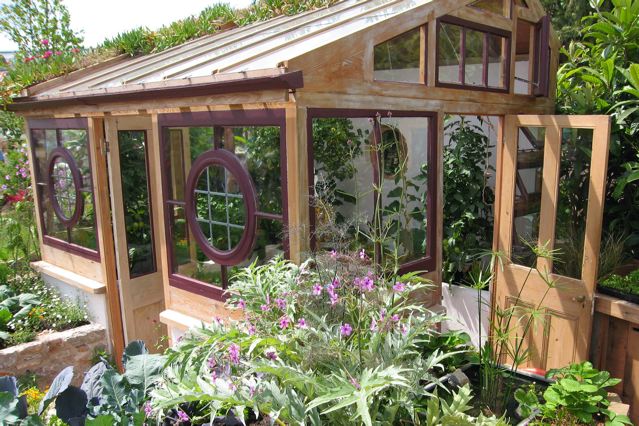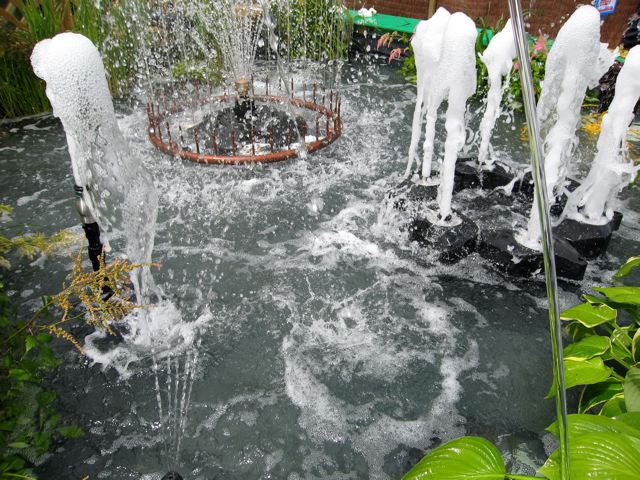With hosepipe bans now in place in many areas, we all need to start tapping into a more joined-up kind of gardening.
Greenhouse gardeners are especially adept at a spot of climate change. When we put up our structures, be they a modest six by four, or something rather grander, the climate over that piece of the earth is dramatically altered. No rain falls there again, while the modern sunshine passing through the glazing warms the now captive interior, creating a whole new world. It’s a world where we can enjoy sowing seeds, taking cuttings, growing our own flowers and food, and, vitally, supping tea.
My own cosy, sun-warmed and climate-altered space is the pivot of my garden. It’s somewhere to plan, to prepare, to grow, and somewhere to bolt to when the heavens open. Every garden in rain-blessed North Wales needs a greenhouse, and yet even here, amid legendary deluges, we humble gardeners wilfully induce drought. Each plant growing in my lean-to is a bit like a patient in a hospital High Dependency Unit: it needs constant attention to survive. I have to keep an eye on how warm/cool it is, check whether its roots need more room, look after its nutritional needs, and decide when it’s fit to face the big outdoors.

But above all else, every plant in my greenhouse is completely reliant on me (especially as I don’t have any soil beds) for that gardening must-have: water. Plants can chug along if they get a bit hungry and root-tight. They’ll flag and sulk, but probably survive, if I misjudge the ventilation – but if I don’t turn up, regularly, with a brimful watering can of the life-giving elixir, it’s curtains.
Greenhouse gardeners are compelled to take responsibility for the bit of local climate reshaping that they’ve brought about; to get the best out of my lean-to’s 144 square feet, I need to harvest and store the rain that’s now deflected by the glass – and more. Alongside sunshine, rainwater is the other mainstay of renewable gardening; catching, storing and using it mindfully is the bedrock of environmentally-sound growing.
Rainwater is plentiful at times, needs no energy-intensive processes to get it from cloud to water butt, is easy to store, and is free. That’s why I got myself a 330-gallon recycled plastic fruit juice tank and plumbed the house roof’s downpipe straight into it. I do most of my watering the low-tech way, using a can, but there’s enough pressure in a full tank to run a semi-automatic watering system of the kind that garden outlets push as the answer to our watering prayers – the type that makes your greenhouse or patio look like a spaghetti junction.
It’s relatively easy for us gardeners to remedy the local, glass-enshrined climate change we bring to our own plots, but when drought rolls out nature-wide, over whole counties, regions, countries and continents, it’s a very different game. We can still be water-savvy in the garden, but with rivers completely drying up, and whole ecosystems collapsing, the reach of our individual efforts is limited.
Ever since a clutch of water companies announced hosepipe bans in the most water-stressed areas of the UK, we’ve been drowning in the gardening media’s stuck record about drought and how to ‘beat it’: water less; do it early, do it late; mulch, mulch, mulch; grow this, not that; use ‘grey’ water from the washing-up bowl; use bigger pots and tubs; set up a ‘drip’ irrigation system. Alongside that, and more, there’s the usual spin that ‘real gardeners’ (whoever they are) are somehow the ‘victims’ when hosepipe bans are introduced. And at the first whiff of dry weather, there’s the predictable leap by gardening trade associations to lobby water companies and government – trade groups which represent the interests of the garden industry, but which often claim to be speaking on behalf of gardeners. They are lobbying not to reduce garden water use, mind, but to maintain it, come what may.

Don’t get me wrong. Most of the practical advice on how to conserve water and how to eke it out – especially where it’s about the stuff from above – is sound enough. But when I see organisations fighting hard to keep gardeners using water that’s fit to drink, which undergoes a series of energy-intensive processes from source to tap, I see another shortage – a drought of joined-up gardening. The one thing which would help to conserve water supplies (on top of all the indoor must-dos, like not flushing after peeing) would be to garden differently. Bluntly, that means not growing plants in high-dependency containers or hanging baskets, but where they should be – in the ground. Gardening without containers: who could imagine such a thing?
Not the garden industry, for sure; having us hooked on container gardening is big business. Think of all the potting compost, plant food, water-retaining granules, pesticides and fungicides that we buy, not to mention the pots, tubs and baskets themselves. Manufacturing all those things requires water – and then, of course, there’s watering itself. In a garden centre during the prelude to the hosepipe bans, I eyeballed horticultural irony incarnate: a huge, wall-mounted hosepipe reel worthy of any sci-fi programme. A more iconic example of the gulf between some gardening dots would be hard to find.
Getting gardening back to the soil, where plants can send down deep, water-searching roots during the tough times, would bring multiple benefits. Planting more care-free perennials – flowers, vegetables and fruits – would involve far less routine soil disturbance (i.e. digging), allowing a settled soil ecosystem to squirrel away more of the carbon that’s driving extreme weather, including drought. It would also make life easier; perennials need little coddling compared to finicky annuals. A root-up rethinking of the way we garden, chivvied on, as we surely will be, by overstretched ecological limits, sounds altogether rather enticing.
Just as necessity spurs us to assume responsibility for our own bit of altered climate inside a greenhouse, we also need to take shared responsibility for the impact of our collective gardening activities inside the bigger global greenhouse. One of the tenets of earth-friendly gardening is that it should give more than it takes. As we turn off one kind of tap, we need to turn another one on: one from which flows a renewed respect for water that will help us grow vibrant gardens, while ending the profligacy of gardening as usual.
Text and images © John Walker










